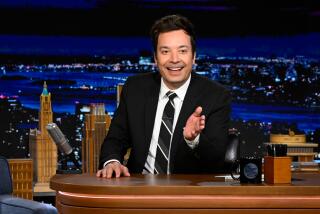Remember the ’55 Fall Season? Pure Gold : Commentary: Eight TV shows that would become classics were introduced. Some can still be seen today in reruns.
- Share via
Whether anything good and long-lasting will come out of the new television season that soon will be upon us, no one can know at this point. One thing is certain, however: It will have to go a long way to beat or even match the fall season of 40 years ago.
The fall of 1955 saw the premiere of eight programs whose renown will probably last as long as television itself.
Add to those newcomers the number of memorable programs already on the air, and remember that they all emerged from only three channels, not 60, and you have some idea why that period is called the Golden Age. (That fall the airwaves would be dominated by the three national networks that for three succeeding decades would be virtually synonymous with American television--ABC, CBS and NBC--the DuMont network having ceased operation in May.)
The eight great premieres were of “Gunsmoke,” “The Lawrence Welk Show,” “The Life and Legend of Wyatt Earp,” “The Millionaire,” “The $64,000 Question,” “Alfred Hitchcock Presents,” “The Phil Silvers Show” and “The Honeymooners.”
The last three regularly crop up on a cable network or local station, and some people consider “The Honeymooners” the best sitcom ever produced--although they would get an argument from fans of “I Love Lucy,” which had been on CBS since Oct. 15, 1951, and which four years later was still among Nielsen’s Top 10 programs.
Strictly speaking, “The Honeymooners” was not born on Oct. 1, 1955. That was merely its inauguration as a weekly series, and that is the one we see in reruns today.
“The Honeymooners” had always been a pet project of Jackie Gleason. It was first seen as a sketch on DuMont’s “Cavalcade of Stars” in 1951, and when Gleason moved to CBS, he took it with him. As a weekly series it lasted only one season (39 episodes), but Gleason revived it again and again as he went on to do other programs.
Of those eight premieres, only two did not belong to CBS: “Lawrence Welk” and “Wyatt Earp,” which were ABC’s. This was the year that CBS for the first time surpassed NBC as the leading network, a position it held for two decades.
In fact, ABC was barely in the running at all. It began life as a radio network spun off from NBC, and for years it struggled to cobble together a TV schedule. When it finally found its legs, they belonged to a horse.
ABC became the oater network. “Wyatt Earp” was its first Western entry, and once it found its niche, it busted it wide open. If not for the prominence of CBS’ “Gunsmoke,” ABC’s “Wyatt Earp” and other Westerns--shows such as “Maverick,” “Tombstone Territory” and “Cheyenne”--might be better remembered.
But “Gunsmoke,” which originated as a radio program, was and is the benchmark Western. And like most of the top shows of the time, it demonstrated a considerable staying power. In fact, it ran for 20 years, longer than any other series with continuing characters. When it left the air in 1975, it was the last Western on network television.
As for the others, “Alfred Hitchcock Presents” (retitled “The Alfred Hitchcock Hour” in 1962 when it was expanded to an hour) ran for 10 years, jumping from CBS to NBC, back to CBS and then to NBC again. “The Lawrence Welk Show” ran on ABC until 1971, when it left the network, but new programs were produced for syndication for 11 more years.
“Wyatt Earp” and “Gunsmoke” brought the “adult Western” to TV. “The $64,000 Question” (which actually began in June rather than the fall) introduced another new idea: the big-time quiz show. It spawned several imitators, including “Twenty-One,” “The Big Surprise” and its own spin-off, “The $64,000 Challenge.” But their success was short-lived: The national scandal surrounding revelations of show-rigging in 1958 killed them off.
The stature of the 1955 season cannot be measured solely by these new programs. Wonderful series continued from earlier years. This was the time of great live television dramas, programs such as NBC’s “Kraft Television Theatre” and “Robert Montgomery Presents” and CBS’ “Climax” and “Studio One” (on which Mike Wallace appeared in two plays). The greatest of them all, however, CBS’ “Playhouse 90,” did not arrive until the next year.
Some of the great names of show business, former stars of vaudeville and movies, were at the peak of their fame at this time and enjoyed long runs on TV. George Burns and Gracie Allen started their show on CBS in 1950 and ended it in 1958 only because Gracie decided to retire. Groucho Marx’s NBC comedy/quiz show, “You Bet Your Life,” began on NBC the same year and lasted until 1961. It had originated on radio in 1947, and for a time it was broadcast over both media.
At least a baker’s dozen of other veteran programs still had strong followings that fall, adding to the distinction of this remarkable season, among them “Dragnet,” “The Ed Sullivan Show,” “The Adventures of Ozzie & Harriet,” “The Perry Como Show,” “Father Knows Best” and “The Danny Thomas Show” (originally called “Make Room for Daddy”).
And lest we make the mistake of thinking that the daily TV schedule ran only from 7 to 11 at night: On the same day that year--Oct. 3--two programs debuted, one in the morning and one in the afternoon, that probably have had as profound an effect on popular culture as any prime-time show. The first was “Captain Kangaroo” and the second was “The Mickey Mouse Club.”
More to Read
The complete guide to home viewing
Get Screen Gab for everything about the TV shows and streaming movies everyone’s talking about.
You may occasionally receive promotional content from the Los Angeles Times.






